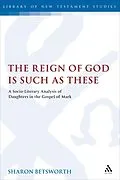This is a new analysis of the 'daughters' in the Gospel of Mark . Betsworth analyzes the 'daughters' in the Gospel of Mark : the woman from the crowd - whom Jesus calls daughter, Jairus' daughter (5:21-43), Herodias' daughter (6:14-29), and the daughter of the Syro-Phoenician woman (7:24-30). To demonstrate how the Gospel's first century audience may have heard these stories, Betsworth begins by examining 'daughters' in their ancient Mediterranean context. Betsworth then considers representations of daughters in select texts from the Septuagint and Greco-Roman literature - from the seventh and sixth centuries B.C.E. to the second century C.E. Although these depictions seem to be in contrast to the social-historical construction of daughters, Betsworth shows that in many ways the literary portrayals of daughters function to uphold the values of Greco-Roman culture - especially those of virginity before and faithfulness in marriage. These two lines of enquiry undergird Betsworth's investigation. From it she is able to show that the 'daughters' in the Gospel uphold the values of the 'reign of God', as an integral part of the Gospel's inclusive social vision of God's reign. This title was formerly the Journal for the Study of the New Testament Supplement , a book series that explores the many aspects of New Testament study including historical perspectives, social-scientific and literary theory, and theological, cultural and contextual approaches.
Autorentext
Sharon Betsworth is the Associate Professor of New Testament at Oklahoma City University, in Oklahoma City, USA.
Inhalt
Acknowledgments
List of Abbreviations
Chapter 1 - Introduction
I. Previous Scholarship on Daughters in the Gospel of Mark
II. Background of the Gospel of Mark
III. Determining the Function of Daughters in the Gospel of Mark
Chapter 2 - Social-Historical Status of and Attitudes about Daughters
I. Greco-Roman Family and Religion
II. The Life of Girls in the Greco-Roman World
III. Attitudes toward Daughters in the Greco-Roman context
IV. Conclusion
Chapter 3 - Literary Representations of Daughters
I. The Homeric Hymn to Demeter
II. Jewish Novels
III. The Plays of Menander
IV. Greek Novels
V. Conclusion
Chapter 4 - The Daughters in the Gospel of Mark
I. The Placement of the Daughter Cycle in the Narrative Context of Mark's Gospel
II. Mark 5. 21-43 - An Older Daughter and a Younger Daughter
a. The Older Daughter from the Crowd
b. The Young Daughter of Jairus
III. Mark 6.14-29 - The Daughter of Herodias
IV. Mark 7. 24-30 - The Daughter of the Syro-Phoenician Woman
V. Daughters and the Reign of God
VI. Jesus as the Son of God
VI. Conclusion
Chapter 5 - Summary and Conclusions
